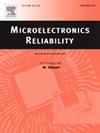IF 1.6
4区 工程技术
Q3 ENGINEERING, ELECTRICAL & ELECTRONIC
引用次数: 0
摘要
碳化硅材料和器件具有高导热性、耐温性和抗恶劣条件的能力,因此在航空航天应用中大有可为。然而,SiC 功率器件经常会遇到高能离子诱发的单次事件效应 (SEE),从而限制了其在太空辐射环境中的应用。在本研究中,我们通过实验和技术计算机辅助设计(TCAD)模拟相结合的方法,证明了在重离子辐照期间,栅极氧化层厚度对碳化硅(SiC)功率金属氧化物半导体场效应晶体管(MOSFET)中潜在栅极氧化物损伤的影响。研究将栅极氧化层厚度分别为 40 纳米和 60 纳米的碳化硅 MOSFET 暴露于 78Kr 离子辐照,然后进行辐照后栅极应力 (PIGS) 测试,仔细研究辐照引起的失效特性。通过 TCAD 仿真,对栅极氧化层的内部动力学进行了仔细研究,发现电场升级和局部能量脉冲主要导致栅极介电层损坏。结果表明,栅极氧化层厚度对潜在的栅极损坏有明显影响,较薄的氧化层更容易发生电击穿。这些发现丰富了对富含辐射环境中 SiC 功率器件可靠性的理解,为航空航天应用提供了宝贵的见解。本文章由计算机程序翻译,如有差异,请以英文原文为准。
Effect of gate oxide thickness on gate latent damage induced by heavy ion in SiC power MOSFETs
SiC materials and devices hold significant promise for aerospace applications owing to their high thermal conductivity, temperature tolerance, and resistance to harsh conditions. However, SiC power devices often encounter single event effects (SEEs) induced by high-energy ions, which limit the applications in space radiation environments. In this study, we demonstrate the impact of thickness of gate oxide layer on latent gate oxide damage in Silicon carbide (SiC) power metal oxide semiconductor field effect transistors (MOSFETs) during heavy-ion irradiation, by using a combination of experiments and technical computer-aided design (TCAD) simulations. The study exposes SiC MOSFETs with gate oxide thicknesses of 40 nm and 60 nm to 78Kr ion irradiation followed by post-irradiation gate stress (PIGS) tests, scrutinizing failure characteristics induced by irradiation. Through TCAD simulations, the internal dynamics of the gate oxide layer are scrutinized, revealing that escalated electric fields and localized energy pulses predominantly precipitate gate dielectric layer damage. The results suggest that gate oxide thickness markedly impacts latent gate damage, with thinner oxide layers exhibiting heightened susceptibility to electrical breakdown. These findings enrich the comprehension of SiC power device reliability in radiation-rich environments, furnishing invaluable insights for aerospace applications.
求助全文
通过发布文献求助,成功后即可免费获取论文全文。
去求助
来源期刊

Microelectronics Reliability
工程技术-工程:电子与电气
CiteScore
3.30
自引率
12.50%
发文量
342
审稿时长
68 days
期刊介绍:
Microelectronics Reliability, is dedicated to disseminating the latest research results and related information on the reliability of microelectronic devices, circuits and systems, from materials, process and manufacturing, to design, testing and operation. The coverage of the journal includes the following topics: measurement, understanding and analysis; evaluation and prediction; modelling and simulation; methodologies and mitigation. Papers which combine reliability with other important areas of microelectronics engineering, such as design, fabrication, integration, testing, and field operation will also be welcome, and practical papers reporting case studies in the field and specific application domains are particularly encouraged.
Most accepted papers will be published as Research Papers, describing significant advances and completed work. Papers reviewing important developing topics of general interest may be accepted for publication as Review Papers. Urgent communications of a more preliminary nature and short reports on completed practical work of current interest may be considered for publication as Research Notes. All contributions are subject to peer review by leading experts in the field.
 求助内容:
求助内容: 应助结果提醒方式:
应助结果提醒方式:


